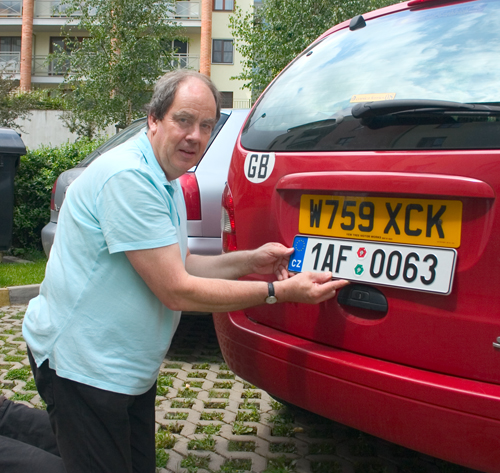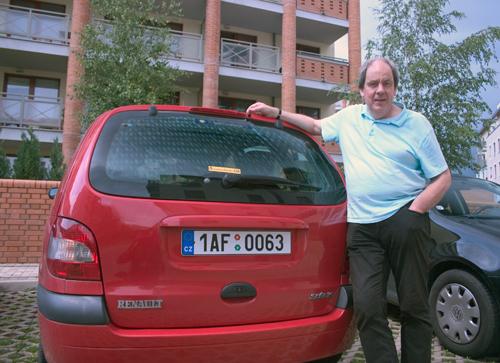

This morning, I walked out of the offices of ‘Praha Hlavní Mesto’ in the centre of Prague with an incredible sense of satisfaction. I had achieved what I had been told so many times, by a whole variety of people, was impossible to achieve. In my rucksack were Czech number plates and a Czech registration document for my previously British registered right-hand drive (RHD) car. Today my red Renault Megane Scenic has legally become a Czech car!

It should really be what we have achieved as I would never have managed to do this without the help and support of Sybille, the knowledge of the whole variety of procedures to obtain the appropriate protocols which came from Adrian Blank of Nepomuk, together with being accompanied through the final stages by Gerry Turner speaking in Czech on my behalf.
In my previous post entitled “Driving on the ‘right’ side of the road”; I explained how Gerry & I had gone to the imposing offices of the Czech Ministry of Transport on Wednesday 3rd June, to submit my application and accompanying papers for a ‘Certificate of Exemption’ for my RHD car. Adrian of Nepomuk had said that I should receive the certificate a week to ten days after submitting the application. When after two weeks, I had neither heard nor received anything; Gerry made a phone call asking what was happening. “Oh it will be in our system and we can take up to four weeks to process it” was the somewhat unhelpful answer given to Gerry. However, on Monday 22nd June, a registered letter arrived at our flat containing the certificate of exemption. The fact that the certificate was dated 17th June 2009, the date of Gerry’s phone call, does seem a little more than coincidence!
On the afternoon of Monday 22nd, I duly delivered the certificate to the Magistrát office in Vysorany, Prague 9 where all my other papers were already lodged. I had to return to the office on Tuesday to put two signatures onto the completed paperwork. Then it was a third visit in three days to collect the completed file on Wednesday. On this third occasion, Gerry accompanied me to ensure I discovered correctly what to do next.
We were told to go to the offices of ‘Praha Hlavní Mesto’ in the centre of Prague, pay 3000 Kc (about £100) environmental fee as my emissions are only ‘Euro 2 standard’, and there I would finally be issued with a Czech registration document and Czech number plates. We hopped on the tram, changed onto the Metro and arrived at the correct office. Through the good offices of Gerry, we explained to the lady on the information desk, what I had come to do. She checked through all the papers giving her approval to everything I had until she asked, “Do you have your insurance certificate with you?” What was the one thing I had not got with me????
So it was that Gerry and I reconvened at the offices of ‘Praha Hlavní Mesto’ at 9.30am this morning. We took our numbered ticket and waited for our number to come up on the electronic board to tell us which kiosk to attend. After about a half hour wait we were summoned.
The lady at kiosk 35 was perfectly friendly. We presented all my papers, including my insurance certificate. “Did I have my passport and residency document with me, not just the photocopies in the file?” Fortunately I had anticipated that one! “Had I personally imported the car?” This question reflects the concern of the Czech authorities of a glut of cheap second-hand British RHD cars being brought into the Czech Republic by unscrupulous dealers. “Did I have 3000 Kc to pay the environmental charge?” I went off to the cash desk, handed over the cash and returned with a receipt.
Then the magic moment came. Number plates were produced from a drawer. Stickers were attached, marked to show the end date of the validity of my mechanical and emissions protocols. A registration document in two parts, showing my new car registration number and my full name and address, came out of the computer printer. All these were presented to me. As a parting gesture, the lady then said to me in Czech, “May God bless you”. Gerry replied by telling her in Czech, how appropriate her words were as she had just said them to the English-speaking Anglican Priest in Prague. The poor lady nearly fell off her chair both with shock and with laughter!
This afternoon, the car underwent it’s transformation from being a British car to being a Czech car. Off came the British number plates and the ‘GB’ sticker. Using the British plates as a template, I successfully drilled two holes in each of the Czech plates and then proudly screwed them onto the car before, of course, posing for the photograph!

